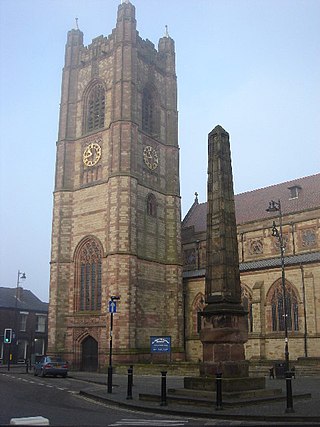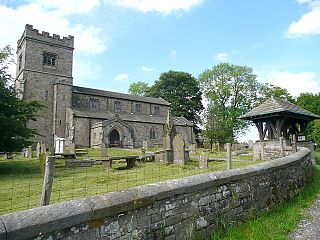
St Peter's Church, Bolton-le-Moors, commonly known as Bolton Parish Church, is a Church of England parish church in Bolton, Greater Manchester, England. The parish church, dedicated to St Peter, is an example of the Gothic Revival style. The church is recorded in the National Heritage List for England as a Grade II* listed building, having been designated in 1974. St Peter's is an active parish church in the Diocese of Manchester and is part of the Bolton deanery and Bolton archdeaconry.

The Parish Church of St Mary the Virgin is a Church of England parish church in Leigh, Greater Manchester, England. It is a member of the Salford & Leigh deanery in the archdeaconry of Salford, diocese of Manchester. It is recorded in the National Heritage List for England as a designated Grade II* listed building.

St John the Baptist's Church is in Market Place, Atherton, Greater Manchester, England. It is an active Anglican parish church in the archdeaconry of Salford, and diocese of Manchester. Together with St George's and St Philip's Churches in Atherton and St Michael and All Angels at Howe Bridge, the church is part of the United Benefice of Atherton and Hindsford with Howe Bridge. It is recorded in the National Heritage List for England as a designated Grade II listed building.

St Peter's Church is in the village of Rylstone, North Yorkshire, England. It is an active Anglican parish church in the deanery of Skipton, the archdeaconry of Craven, and the Diocese of Leeds. Its benefice is united with that of St Wilfrid, Burnsall. The church is recorded in the National Heritage List for England as a designated Grade II listed building.

St Peter's Church is in the village of Quernmore, Lancashire, England. It is an active Anglican parish church in the deanery of Lancaster and Morecambe, the archdeaconry of Lancaster, and the diocese of Blackburn. Its benefice is united with those of St Mark, Dolphinholme, and Christ Church, Over Wyresdale. The church is recorded in the National Heritage List for England as a designated Grade II listed building. It stands in a relatively isolated position about 1 mile (1.6 km) to the north of the village and 2.5 miles (4.0 km) to the east of the city of Lancaster.

St James' Church is in the Poolstock district of Wigan, Greater Manchester, England. It is an active Anglican parish church in the deanery of Wigan, the archdeaconry of Wigan & West Lancashire, and the diocese of Liverpool. The church is recorded in the National Heritage List for England as a designated Grade II* listed building.

Ulverston Parish Church is in Church Walk, Ulverston, Cumbria, England. It is an active Anglican parish church in the deanery of Furness, the archdeaconry of Westmorland and Furness, and the diocese of Carlisle. Its benefice is united with that of St John, Osmotherley. The church is recorded in the National Heritage List for England as a designated Grade II* listed building.

Preston Minster, formally the Minster Church of St John the Evangelist, is in Church Street, in the centre of Preston, Lancashire, England. From its origin it has been the parish church of Preston. It is an active Anglican church in the deanery of Preston, the archdeaconry of Lancaster and the diocese of Blackburn. Its benefice is united with that of St George, Preston. St John's is recorded in the National Heritage List for England as a designated Grade II* listed building.

St Michael and All Angels' Church is in Leigh Road, Howe Bridge, a suburb of Atherton, Greater Manchester, England. It is an active Anglican parish church in the deanery of Leigh, the archdeaconry of Salford and the diocese of Manchester. Its benefice is united with those of three local churches, St John the Baptist, St George and St Philip, forming a team ministry entitled the United Benefice of Atherton and Hindsford with Howe Bridge. The church is recorded in the National Heritage List for England as a designated Grade II* listed building.

St Mary Magdalene's Church is located in Church Street, Clitheroe, Lancashire, England. It is the Anglican parish church of the town, and is in the deanery of Whalley, the archdeaconry of Blackburn, and the diocese of Blackburn. The church, dedicated to Jesus' companion Mary Magdalene, is recorded in the National Heritage List for England as a designated Grade II* listed building.

St Andrew's Church is in Main Street, Sedbergh, Cumbria, England. It is an active Anglican parish church in the deanery of Kendal, and the diocese of Carlisle. Its benefice is united with those of St Mark, Cautley, and St John the Baptist, Garsdale, to form the benefice of Sedbergh, Cautley and Garsdale.The Parish is also part of the Western Dales Mission Community. The church is recorded in the National Heritage List for England as a designated Grade I listed building.

St Michael and All Angels with St Marks Church is in Egerton Road, Ashton-on-Ribble, Preston, Lancashire, England. It is an active Anglican parish church in the deanery of Preston, the archdeaconry of Lancaster, and the diocese of Blackburn. Its benefice is united with those of St Mark, Preston, and St Andrew, Ashton-on-Ribble, to form the benefice of the West Preston Team. The church is recorded in the National Heritage List for England as a designated Grade II* listed building.

All Saints' Church is in Queens Road, Hertford, Hertfordshire, England. It is an active Anglican parish church in the deanery of Hertford and Ware, the archdeaconry of Hertford, and the diocese of St Albans. It is the civic church of the town and of the county. The church is recorded in the National Heritage List for England as a designated Grade II* listed building. It is the largest church in Hertfordshire, other than St Albans Cathedral, and can seat up to 1,000 people.

St Paul's Church is in Church Road, Skelmersdale, Lancashire, England. It is an active Anglican parish church in the deanery of Ormskirk, the archdeaconry of Warrington, and the diocese of Liverpool. The church is recorded in the National Heritage List for England as a designated Grade II listed building.

St John's Church is in Chapel Lane, Ellel, Lancashire, England. It is an active Anglican parish church in the deanery of Lancaster and Morecambe, the archdeaconry of Lancaster, and the diocese of Blackburn. The church is recorded in the National Heritage List for England as a designated Grade II listed building. The authors of the Buildings of England series describe the appearance of the church as being "decidedly monumental".

St Mary the Virgin's Church is located on the Promenade, Walney Island, Barrow-in-Furness. Cumbria, England. It is an active Anglican parish church in the deanery of Barrow, the archdeaconry of Westmorland and Furness, and the diocese of Carlisle. The church is recorded in the National Heritage List for England as a designated Grade II listed building.

St Wilfrid and St Ann's Church is in Oldham Road, Newton Heath, Greater Manchester, England. It is a redundant Anglican parish church, which is recorded in the National Heritage List for England as a designated Grade II listed building.

St Michael & All Angels Church is located to the southwest of the English village of Cockerham, Lancashire. It is an active Anglican parish church in the deanery of Lancaster, the archdeaconry of Lancaster and Morecambe, and the diocese of Blackburn. Its benefice is combined with those of Christ Church, Glasson, and St Luke, Winmarleigh. The church is recorded in the National Heritage List for England as a designated Grade II* listed building.

St Stephen's Church is in Balcarres Avenue, Whelley, Wigan, Greater Manchester, England. It is an active Anglican parish church in the deanery of Wigan, the archdeaconry of Wigan and West Lancashire, and the diocese of Liverpool. Its benefice is united with that of St John, New Springs. The church is recorded in the National Heritage List for England as a designated Grade II listed building.

St Thomas' Church is in Warrington Road, Ashton-in-Makerfield, Greater Manchester, England. It is an active Anglican parish church in the deanery of Wigan, the archdeaconry of Warrington, and the diocese of Liverpool. Its benefice is united with that of St Luke, Stubshaw Cross. The church is recorded in the National Heritage List for England as a designated Grade II listed building.






















